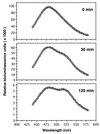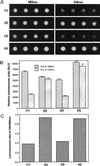A bioluminescence resonance energy transfer (BRET) system: application to interacting circadian clock proteins
- PMID: 9874787
- PMCID: PMC15108
- DOI: 10.1073/pnas.96.1.151
A bioluminescence resonance energy transfer (BRET) system: application to interacting circadian clock proteins
Abstract
We describe a method for assaying protein interactions that offers some attractive advantages over previous assays. This method, called bioluminescence resonance energy transfer (BRET), uses a bioluminescent luciferase that is genetically fused to one candidate protein, and a green fluorescent protein mutant fused to another protein of interest. Interactions between the two fusion proteins can bring the luciferase and green fluorescent protein close enough for resonance energy transfer to occur, thus changing the color of the bioluminescent emission. By using proteins encoded by circadian (daily) clock genes from cyanobacteria, we use the BRET technique to demonstrate that the clock protein KaiB interacts to form homodimers. BRET should be particularly useful for testing protein interactions within native cells, especially with integral membrane proteins or proteins targeted to specific organelles.
Figures




Similar articles
-
Circadian rhythms of cyanobacteria: monitoring the biological clocks of individual colonies by bioluminescence.J Bacteriol. 1994 Apr;176(7):1881-5. doi: 10.1128/jb.176.7.1881-1885.1994. J Bacteriol. 1994. PMID: 8144454 Free PMC article.
-
Bioluminescence resonance energy transfer-based imaging of protein-protein interactions in living cells.Nat Protoc. 2019 Apr;14(4):1084-1107. doi: 10.1038/s41596-019-0129-7. Epub 2019 Mar 25. Nat Protoc. 2019. PMID: 30911173
-
Combining protein complementation assays with resonance energy transfer to detect multipartner protein complexes in living cells.Methods. 2008 Jul;45(3):214-8. doi: 10.1016/j.ymeth.2008.06.006. Epub 2008 Jun 27. Methods. 2008. PMID: 18586102
-
Monitoring Ligand-Activated Protein-Protein Interactions Using Bioluminescent Resonance Energy Transfer (BRET) Assay.Methods Mol Biol. 2016;1473:3-15. doi: 10.1007/978-1-4939-6346-1_1. Methods Mol Biol. 2016. PMID: 27518618 Review.
-
Circadian programs in cyanobacteria: adaptiveness and mechanism.Annu Rev Microbiol. 1999;53:389-409. doi: 10.1146/annurev.micro.53.1.389. Annu Rev Microbiol. 1999. PMID: 10547696 Review.
Cited by
-
BRET Biosensor Analysis of Receptor Tyrosine Kinase Functionality.Front Endocrinol (Lausanne). 2013 Apr 9;4:46. doi: 10.3389/fendo.2013.00046. eCollection 2013. Front Endocrinol (Lausanne). 2013. PMID: 23577003 Free PMC article.
-
Developments in FRET- and BRET-Based Biosensors.Micromachines (Basel). 2022 Oct 20;13(10):1789. doi: 10.3390/mi13101789. Micromachines (Basel). 2022. PMID: 36296141 Free PMC article. Review.
-
Roles for sigma factors in global circadian regulation of the cyanobacterial genome.J Bacteriol. 2002 Jul;184(13):3530-8. doi: 10.1128/JB.184.13.3530-3538.2002. J Bacteriol. 2002. PMID: 12057947 Free PMC article.
-
A system for quantifying dynamic protein interactions defines a role for Herceptin in modulating ErbB2 interactions.Proc Natl Acad Sci U S A. 2006 Dec 12;103(50):19063-8. doi: 10.1073/pnas.0605218103. Epub 2006 Dec 5. Proc Natl Acad Sci U S A. 2006. PMID: 17148612 Free PMC article.
-
Dopamine D2L Receptor Deficiency Causes Stress Vulnerability through 5-HT1A Receptor Dysfunction in Serotonergic Neurons.J Neurosci. 2019 Sep 18;39(38):7551-7563. doi: 10.1523/JNEUROSCI.0079-19.2019. Epub 2019 Aug 1. J Neurosci. 2019. PMID: 31371425 Free PMC article.
References
Publication types
MeSH terms
Substances
Grants and funding
LinkOut - more resources
Full Text Sources
Other Literature Sources
Molecular Biology Databases

